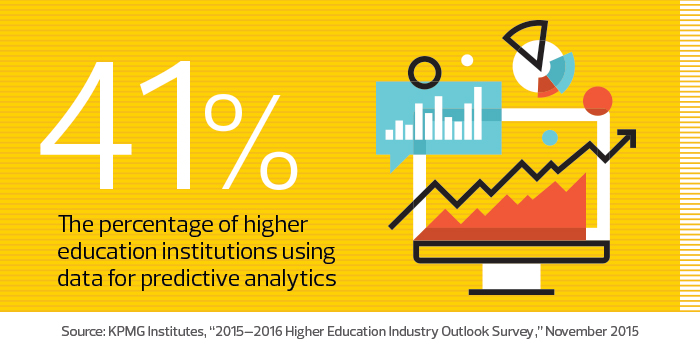Beyond Retention: Colleges Expand Data Analytics to Business and Finance Operations
At colleges large and small, Big Data is much more than a buzzword. Nearly half of higher education institutions are harnessing it to boost retention, employing predictive analytics to identify students who may be at risk in hopes of keeping them moving toward graduation. Yet increasingly, colleges are leveraging data analytics to forecast their revenues, target fundraising efforts and streamline business operations.
Jon Allen knows the breadth of data analytics firsthand. As the CISO and assistant vice president at Baylor University in Waco, Texas, he and his team took Splunk software and turned it into a Swiss army knife for managing data across a network of more than 20,000 machines.

Jon Allen, CISO, Baylor University.
Allen began using Splunk on a small scale about four years ago, simply to comply with peripheral component interconnect requirements for network log monitoring. But the longer the university looked at Splunk, the more ways they found to use it, he says. What began as a straightforward application grew into a software license that now consumes 400 gigabytes per day
For example, Baylor uses Splunk to slash turnaround time on help desk queries, such as assisting users who are locked out of their accounts. Now, instead of spending hours poring over logs for each domain controller, server admins can throw them into Splunk and find the answer in minutes.
“This is basically Google for your machine data,” says Allen. “ ‘How am I going to understand what is going on with all these logs?’ That’s what Splunk does.”
Data Provides a Clear Vision into Operations
As CISO, Allen uses Splunk to analyze network logins and correlate threat data between the server logs, firewalls and intrusion prevention systems. Baylor has even used Splunk data to predict the best places to install access points as its wireless network expands. More recently, Baylor has brought in logs from some of the 130-plus cloud services it has deployed, such as Box, CrashPlan, Duo and Fischer IDM.
“Now we have visibility into our hybrid data center,” says Allen. “I don’t care if something is happening in the cloud or on-premises. I can see what’s going on inside my organization.”
Allen says that Baylor has barely tapped Splunk’s potential for predictive analysis across a range of university departments eager to take advantage of its capabilities. The real value of Splunk, Allen says, is its ability to deliver not only information, but insight: “I can have gigs and gigs of data — who cares? But if I can actually make something meaningful and actionable out of that data, that’s important.”
Addressing the Retention Question
Many universities are just starting to take advantage of Big Data tools, says Alan Duncan, a research director at Gartner. Others are still at the talking stage.
Much of the discussion centers on how to ensure students stay in college long enough to complete their degrees, he says. By tracking data such as students’ test scores and level of engagement in online learning environments, institutions seek to identify students at risk and intervene before it’s too late.
Retention rates also have serious financial implications: If students drop out, a university could lose out on tuition payments. Beyond that, it costs more to recruit a student — think marketing, travel and administration expenses — than to retain one. In the long term, students who don’t finish college are less likely to pay off their student loans and to support an alma mater as donors.
“There are both academic outcomes and institutional outcomes, and the two can be uncomfortable bedfellows,” Duncan says. “Institutions are interested in the welfare of students, but they also have to get paid for the educational services they provide.”
Analytics for Financial Forecasting
Budgeting and financial forecasting are the primary reasons that Northwestern University outside Chicago uses IBM Cognos TM1, says Lauren J. Pahnke, senior systems analyst for Northwestern’s finance, facilities and research administration systems.
In preparation for each fiscal year, every department submits a projected budget. These are entered into Cognos TM1 and imported into the university’s financial system, where adjustments can be made once the fiscal year begins, Pahnke says. The university then brings budgets and actual numbers back into TM1’s forecasting application, which departments use to track their financials over the course of the year.
“We used to do all this in Excel,” she says. “But it’s just not maintainable. Now we can see the detail going into people’s calculations, where the numbers came from and what their assumptions were. Before TM1, we couldn’t see any of that.”
In 2015, Northwestern added a tuition forecasting module that lets managers of academic programs enter an estimated head count and tuition rate, then project what a program’s revenue will look like and where it will flow, says Pahnke. However, adoption of that forecasting tool has been slower than anticipated.
“We hope people will use it because this is the kind of thing TM1 is very good at,” she says. “I think there’s a big need for it, but it’s harder for people to make that transition. Our central budget office definitely sees the value in it.”

Need for Speed in Solving IT Issues
In the future, data analysis applications are likely to become more varied as staff in diverse departments recognize their potential. For now, the biggest impact of solutions like Splunk and Cognos is often felt in IT departments, particularly when such tools enable teams to accomplish more with fewer resources.
At Laguna College of Art + Design in suburban Los Angeles, for example, a two-person IT staff is responsible for approximately 1,000 students, staff and faculty. LCAD uses Splunk as a force multiplier, automating the collection and analysis of network log files, says Shawn Tetzlaff, the academic computing administrator.
With Splunk, Tetzlaff can see how well each server is performing, how often it restarts and if students are committing access violations by illegally downloading movie or music files. Besides preserving bandwidth, the latter is important because LCAD, like all colleges, must comply with the Higher Education Opportunity Act, which requires institutions to make a good-faith effort to combat copyright violations.
It used to take 25 minutes to work backward from an IP address to figure out which student was violating the college’s acceptable-use policy. Splunk has reduced that time to less than five minutes, which frees up Tetzlaff for more important tasks.
“The speed at which Splunk queries the database and the nearly unlimited ability it gives you to parse that data is fantastic,” he says. “It’s already paid dividends in saving time for me, and I figure if it can save me that much time, we can figure out how to make it work for others. We’re still in the fledgling stages of realizing its full potential.”









